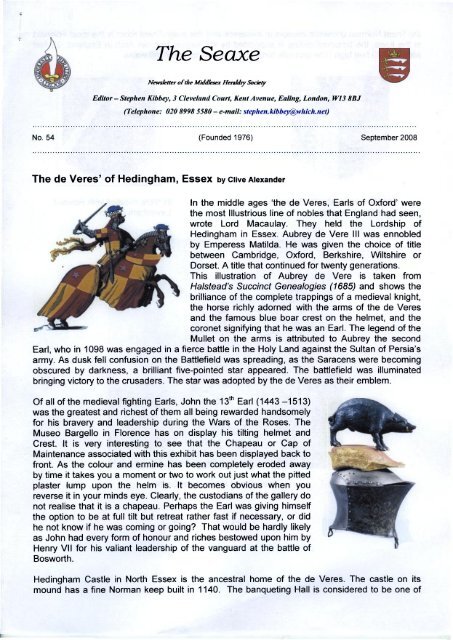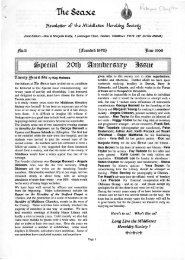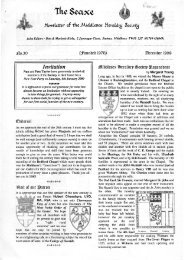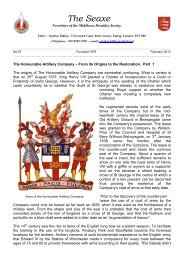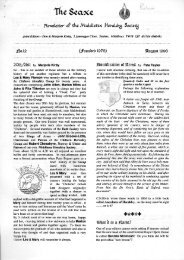The Seaxe - Middlesex Heraldry Society
The Seaxe - Middlesex Heraldry Society
The Seaxe - Middlesex Heraldry Society
You also want an ePaper? Increase the reach of your titles
YUMPU automatically turns print PDFs into web optimized ePapers that Google loves.
<strong>The</strong> <strong>Seaxe</strong><br />
Newsletter of the <strong>Middlesex</strong> <strong>Heraldry</strong> <strong>Society</strong><br />
Editor - Stephen Kibbey, 3 Cleveland Court, Kent Avenue, Ealing, London, W13 8BJ<br />
(Telephone: 020 8998 5580 - e-mail: stephen.kibbey@which.net)<br />
No. 54 (Founded 1976) September 2008<br />
<strong>The</strong> de Veres' of Hedingham, Essex by Clive Alexander<br />
In the middle ages 'the de Veres, Earls of Oxford' were<br />
the most Illustrious line of nobles that England had seen,<br />
wrote Lord Macaulay. <strong>The</strong>y held the Lordship of<br />
Hedingham in Essex. Aubrey de Vere III was ennobled<br />
by Empress Matilda. He was given the choice of title<br />
between Cambridge, Oxford, Berkshire, Wiltshire or<br />
Dorset. A title that continued for twenty generations.<br />
This illustration of Aubrey de Vere is taken from<br />
Halstead's Succinct Genealogies (1685) and shows the<br />
brilliance of the complete trappings of a medieval knight,<br />
the horse richly adorned with the arms of the de Veres<br />
and the famous blue boar crest on the helmet, and the<br />
coronet signifying that he was an Earl. <strong>The</strong> legend of the<br />
Mullet on the arms is attributed to Aubrey the second<br />
Earl, who in 1098 was engaged in a fierce battle in the Holy Land against the Sultan of Persia's<br />
army. As dusk fell confusion on the Battlefield was spreading, as the Saracens were becoming<br />
obscured by darkness, a brilliant five-pointed star appeared. <strong>The</strong> battlefield was illuminated<br />
bringing victory to the crusaders. <strong>The</strong> star was adopted by the de Veres as their emblem.<br />
Of all of the medieval fighting Earls, John the 13 th<br />
Earl (1443 -1513)<br />
was the greatest and richest of them all being rewarded handsomely<br />
for his bravery and leadership during the Wars of the Roses. <strong>The</strong><br />
Museo Bargello in Florence has on display his tilting helmet and<br />
Crest. It is very interesting to see that the Chapeau or Cap of<br />
Maintenance associated with this exhibit has been displayed back to<br />
front. As the colour and ermine has been completely eroded away<br />
by time it takes you a moment or two to work out just what the pitted<br />
plaster lump upon the helm is. It becomes obvious when you<br />
reverse it in your minds eye. Clearly, the custodians of the gallery do<br />
not realise that it is a chapeau. Perhaps the Earl was giving himself<br />
the option to be at full tilt but retreat rather fast if necessary, or did<br />
he not know if he was coming or going? That would be hardly likely<br />
as John had every form of honour and riches bestowed upon him by<br />
Henry VII for his valiant leadership of the vanguard at the battle of<br />
Bosworth.<br />
Hedingham Castle in North Essex is the ancestral home of the de Veres. <strong>The</strong> castle on its<br />
mound has a fine Norman keep built in 1140. <strong>The</strong> banqueting Hall is considered to be one of
the finest Norman domestic interiors in existence and this magnificent room is the most splendid<br />
in the keep, the timbered ceiling is supported by the largest Norman Arch in England, 28 feet<br />
wide and 20 feet high. <strong>The</strong> grounds have many charming woodland walks.<br />
de Vere impaled with Sergeaux<br />
Lavenham Church<br />
<strong>The</strong> keep at Hedingham Castle.<br />
de Vere impaled with Howard<br />
Lavenham Church
John, 15th Earl of Oxinford, K.G. 1527, died 6 March, 1540.<br />
Arms: quarterly of seven, (1) Vere, (2) Colbroke, (3) Clare, (4)<br />
Serjaulx, (5) Badlesmere, (6) Samford, (7) FitzHamon. <strong>The</strong> staff<br />
supported by "the blue boar" crined gold.<br />
Banner of John, Earl of Oxford K.G. from Banners Standards and Badges from a Tudor<br />
Manuscript in the College of Arms. <strong>The</strong> De Walden Library 1904.
<strong>The</strong> Quarterly Coat of the Mandevilles and associated families.<br />
Mandeville fitz Piers Beauchamp of Beauchamp of<br />
Say fitz Geoffrey Bedford Bedford<br />
de Vere de Lacy de Lacy Sackville<br />
fitz Robert of Clavering<br />
Fitz Roger Despencer Rochford Berners<br />
<strong>The</strong>re is a family tree of the Quarterly coat by Sir Anthony Wagner in Medieval England, Vol. 1<br />
edited by A.L.Poole, 1958. Any member who would like a copy of this family tree apply to the<br />
editor.
Visit to the Worshipful Company of Armourers and Braziers Company -<br />
April 2007 by Clive Alexander<br />
A wooden carving of St George, the patron saint of the<br />
Armourers' Company, wearing real armour. This was<br />
carried on their barge.<br />
Our party was cordially received by the<br />
Company Clerk, Commodore Christopher<br />
Waite RN, who gave a short talk about the<br />
work of the company. <strong>The</strong> Armourers, he<br />
explained were instituted by ordinance in<br />
1322, receiving their first Charter in 1453.<br />
After absorbing the Blacksmiths in 1515 and<br />
later the Helmet Makers and Armour<br />
Repairers, workers in brass and copper<br />
were incorporated in 1708. Progress in<br />
metallurgy is encouraged by research<br />
fellowships, scholarships at Oxford, and<br />
prizes to Sheffield cutlery apprentices and to<br />
the students of metallurgy and engineering<br />
at Sheffield College of Technology and the<br />
City and Guilds of the London Institute. <strong>The</strong><br />
Hall stands on a site leased in 1346 and<br />
later purchased in 1428. <strong>The</strong> Hall survived<br />
the Great Fire and was rebuilt by William<br />
Cresswell in 1795. <strong>The</strong> present Hall was<br />
built by J H Good in 1840. Today the Hall<br />
contains an important collection of armour,<br />
plate and paintings all displayed in a<br />
sumptuous suite of rooms. <strong>The</strong> armour<br />
displayed is a testament to the skill of the<br />
metalworkers of the Tudor period.<br />
<strong>The</strong>re are some fine pieces of furniture<br />
representative of different periods, not least<br />
of which is a complete and very rare set of<br />
Regency interlocking banqueting tables.<br />
<strong>The</strong> party could not fail to be impressed by the Great Hall where the wall panelling is covered<br />
with the armorials of past Wardens and Company worthies. On display also, was the<br />
Company's gold and silver ceremonial plate flanking a very detailed and beautifully executed<br />
bronze statue on St George and the Dragon. <strong>The</strong> visit, which was greatly appreciated by our<br />
party concluded with tea and biscuits in the lounge.<br />
<strong>The</strong> Companies Arms were Granted 15 October 1556 to <strong>The</strong> Frateritye or Guylde of St George<br />
of the mystery of Armourors'. <strong>The</strong> company customarily adds a second shield (Accollé with the<br />
first) supporters and a motto. A second crest is sometimes seen. <strong>The</strong>se are of no authority. A<br />
very grand three dimensional model of the complete achievement stands in its own dedicated<br />
recess in the cornice at eaves level.<br />
Arms: Dexter, the armourers: Argent on a chevron sable an "attõney"(tournament) gauntlet<br />
between two pairs of swords in saltire argent the swords porfled pommelled and hilted or, on a<br />
chief sable in a plate between two helmets argent garnished or a cross gules.<br />
Sinister, the Brasiers: azure on a chevron between two ewers in chief and a three -legged pot<br />
with handles in base all or, three roses gules seeded or barbed vert.
Crest: On a wreath argent and sable a demi-man of war armed argent open-faced porfled or<br />
holding in his hand a mace of war.<br />
Supporters: Two men in complete armour proper, the dexter argent garnished or, the sinister<br />
all or; on their heads plumes of feathers, and each holding in his exterior hand a sword proper.<br />
Mantling: Gules doubled argent.<br />
Mottoes: Make all sure. We are one.<br />
It seems that the Armourers previously used: 'Sable a battle-axe and a tilting spear both or head<br />
argent in saltire debruised by a cross couped gules all between three helms argent'. <strong>The</strong>se<br />
arms are recorded in a manuscript c.1530, (Vincent, "Two Ears of Wheat), in the College of<br />
Arms. However, there seemed to be some uncertainty "under what sorte and maner theire<br />
predecessors bare" them. To rectify the situation, as mentioned above, the Company were<br />
granted the following arms dated 15 th<br />
October 1556 by Thomas Hawley, Clarenceux King of<br />
Arms: "Silver on a chevron sable a attorny gawntelet betwene Fower Swordes in Sawltre porfled<br />
pomeled and hilted gold on a chief sable in a plate betwene two hellmettes silver garnyshed<br />
golde a playne crosse geules. Upon the healme on a Torse silver and sable a demy Man of<br />
Armes armed silver open faced porfled golde holdyng in his hande a mace of warre manteled<br />
geules dobled silver". Ed.
Did you know...?<br />
<strong>The</strong> current Great Seal<br />
Arms in the <strong>Middlesex</strong> Guildhall by Rupert Barnes<br />
... that HM <strong>The</strong> Queen has had two Great Seals struck in<br />
her reign. <strong>The</strong> first was designed by Gilbert Ledward and<br />
came into service in 1953. Through long usage and the heat<br />
involved in the sealing process, the matrix lost definition. In<br />
2001 a new Great Seal, designed by sculptor James Butler<br />
and produced by the Royal Mint, came in use.<br />
<strong>The</strong>re are three different coloured sealing waxes, dark<br />
green, blue and scarlet red. <strong>The</strong> colour used depends on<br />
the nature of the document being sealed. Dark green is<br />
used for letters patent for the peerage, blue is for<br />
documents for close members of the royal family and scarlet<br />
red is used for letters patent for nominating bishops and<br />
most other patents<br />
In June 2007 I visited <strong>Middlesex</strong> Guildhall at the invitation of the Ministry of Justice. I was to<br />
look over the Guildhall before the builders moved in for a two and a half year task of conversion,<br />
for <strong>Middlesex</strong> Guildhall is to become the seat of the new Supreme Court of the United Kingdom<br />
and of the Judicial Committee of the Privy Council.<br />
<strong>The</strong> <strong>Middlesex</strong> Guildhall is a secular gothic<br />
masterpiece. It stands on Parliament Square, looking<br />
out at two grand triumphs mediæval and revival gothic<br />
architecture; Westminster Abbey and the Palace of<br />
Westminster. <strong>The</strong> Guildhall itself follows the theme<br />
with gusto, and the main Council Chamber imitates a<br />
mediæval great hall. Nevertheless, it is a twentieth<br />
century building; built in 1913 for <strong>Middlesex</strong> County<br />
Council and the Quarter Sessions.<br />
A riot of late Gothic Revival in harmonious collision<br />
with the Arts and Crafts Movement, the <strong>Middlesex</strong><br />
Guildhall is a jewel conceived by the architect, James<br />
Gibson. Its exterior stonework runs with sculpture<br />
from the wild imagination of the sculptor, H C Fehr.<br />
Inside it breaks out into colour and texture. <strong>The</strong><br />
Guildhall is not a decorated building but a hall built as<br />
art; the intensity of ornament and ostentation is all<br />
integral to the structure as a single conception. <strong>The</strong><br />
ornament is symbolic; one of my challenges has been<br />
to read it. A major element of the symbolism is<br />
heraldic.<br />
As I approached the Guildhall I could look up at a large<br />
Sir William Prescott CBE DL<br />
<strong>Middlesex</strong> County Council shield carved in stone over<br />
the main door. (In the conversion it is to be covered over with the royal arms.) Below the shield<br />
are Fehr's grand historical friezes; King John grants Magna Carta, King Henry III grants a
charter to Westminster Abbey, and Lady Jane Grey receives the Crown of England. Beneath<br />
each scene are bosses with the arms or attributed arms of the personages portrayed. Above, a<br />
tower rises high. Around its parapet runs a jaunty selection of lions, unicorns, yales, Tudor<br />
roses, thistles and shields.<br />
<strong>The</strong> <strong>Middlesex</strong> Arms<br />
Some county councils have decorated their palaces<br />
with representations of the boroughs within their<br />
area, but here there is none of that; only <strong>Middlesex</strong><br />
itself is celebrated. <strong>The</strong> arms of <strong>Middlesex</strong> (or rather<br />
of the former County Council) appear throughout the<br />
Guildhall: Gules, three seaxes fessewise points to<br />
the sinister proper, pomels and hilts and in the centre<br />
chief point a Saxon crown or. <strong>The</strong> arms were<br />
granted in 1910 and the councillors must have been<br />
proud of them. <strong>The</strong>y appear in the curlicues of the<br />
wrought iron Grand Stairs, on fireplaces, on<br />
lampshades and elsewhere. <strong>The</strong> finest<br />
representation is in a stained glass window in the<br />
Council Chamber, and there in place of a motto,<br />
three ribbons to the sides and bottom of the shield<br />
read "Colne - Thames - Lea"; the three rivers which<br />
mark the bounds to west, south and east of the<br />
historic county. From three cornucopias behind the<br />
shield, water gushes down to join in one stream<br />
beneath.<br />
<strong>The</strong> most prominent heraldry is in stained glass. <strong>The</strong> windows are a library of the worthies of<br />
<strong>Middlesex</strong>.<br />
<strong>The</strong> Council Chamber is the main showpiece. Its broad hammer-beam roof, spans the room<br />
with dark timbers between life-sized shield-bearing angels. <strong>The</strong> fat bosses are of roses,<br />
portcullises and other such badges. <strong>The</strong> windows on both sides of the Chamber bear the arms<br />
of <strong>Middlesex</strong> and of the Lord-Lieutenants of <strong>Middlesex</strong> from the eighteenth century; in order, the<br />
Duke of Northumberland, the Duke of Portland, the Marquess of Salisbury, the Duke of<br />
Wellington, the Earl of Strafford and the Duke of Bedford. This grand room will become the<br />
principal courtroom for the Supreme Court.<br />
<strong>The</strong> same Lord Lieutenants' arms appear in the windows of the Chamber's ante room and of<br />
the Grand Staircase, where they are joined by those of the Duke of Newcastle. Newcastle's<br />
arms are a bit of a puzzle; I have not found a reliable representation elsewhere that matches<br />
that in the window. Here they are quarterly by six, with the 1st and 6th quarters quartering 3<br />
pelicans in their piety (for Pelham) with ermine, two piles in point (for Holles). King Philippe's<br />
buckles are in the 2nd quarter on their own, not quartered with Pelham as usual. <strong>The</strong> Duke<br />
possibly changed his arms in his lifetime though as he adopted the Holies legacy and other<br />
inheritances he received (and squandered).<br />
<strong>The</strong> original Quarter Sessions court rooms have heraldic windows too. In Court 1 are arms of<br />
sheriffs to 1913. <strong>The</strong> <strong>Middlesex</strong> shrievalty was restored only in 1889; before then two sheriffs a<br />
year were had been appointed by the Corporation of London. Eight sheriffs' arms appear in<br />
Court 1 and three others, with three more earlier sheriffs on the Grand Stairs.<br />
<strong>The</strong> windows in Court 2 are later, and bear the arms of four sheriffs after 1913. (How they<br />
chose the sheriffs to immortalize in this way I do not know; perhaps a subscription was taken up<br />
for the popular ones!)
I identified the Lord Lieutenants swiftly enough. <strong>The</strong> sheriffs' arms were more of a challenge.<br />
Encouraged and assisted by Stephen Kibbey I began my research. <strong>The</strong> later sheriffs in Court 2<br />
were no challenge; they each have a name and date beneath. In Court 1, in the absence of an<br />
official record, I had to pour over books to identify each. I found that three are not sheriffs but<br />
supernumerary worthies; one Chairman of Quarter Sessions, the remarkable Sir Montagu<br />
Sharpe, one Vice-Chairman, MP and government minister, the inimitable Sir Herbert Nield, and<br />
one I have still not identified, the frustrating Mr Incognito.<br />
<strong>The</strong> arms displayed in the <strong>Middlesex</strong> Guildhall are a library in themselves, and a colourful<br />
display of arms both ancient and new-minted.<br />
<strong>The</strong> conversion work in the Guildhall will be dramatic. In one place, three rooms have been<br />
knocked into one, not in the usual way but vertically; the floor I walked on in Court 1 is now thin<br />
air and the room become the upper gallery of a library. <strong>The</strong> sheriffs will remain but high above<br />
the floor. At the same time, the cluttered light-wells will be cleared of modern encumbrances<br />
and restored as once they were, so the windows will shine brightly once more.<br />
All the stonework and woodwork is undergoing restoration. <strong>The</strong> grime of a century is coming<br />
off. <strong>The</strong> windows have decayed, crazed and faded, but an expert firm of restorers has been<br />
brought in.<br />
<strong>The</strong> Council Chamber has undergone a change<br />
which has caused outrage amongst the<br />
conservators or heritage (and a doomed judicial<br />
review by "Save Britain's Heritage"). <strong>The</strong><br />
hammer-beam roof, the angels and the stained<br />
glass windows will remain. Below, though<br />
everywhere was gorgeous carved wood furniture,<br />
from the Chairman's throne and throughout the<br />
oaken seats for the councillors, all carved with<br />
loving care in the Gothic idiom filling the space as<br />
an artistic whole. This noble room has been<br />
stripped bare. Some of Fehr's individually carved<br />
bench-ends and pew-ends will stay (with carved<br />
lions, dogs and beasts whose identities have been<br />
lost to the rubbing of decades of anxious hands).<br />
<strong>The</strong> room will echo in emptiness still.<br />
For all the changes of form and function, the<br />
<strong>Middlesex</strong> connection will not be all lost.<br />
<strong>Middlesex</strong> is crafted into every aspect of the fabric<br />
of the Guildhall. It will remain a monument<br />
Arms of Sir John Gibbons, 5 to <strong>Middlesex</strong>. I was encouraged by one<br />
continued <strong>Middlesex</strong> tradition. <strong>Middlesex</strong> Day, 16<br />
May, remembers the day the county regiment<br />
stood fast and died hard at Albuhera in 1811. <strong>The</strong> day is still marked by the raising of the<br />
<strong>Middlesex</strong> flag from the flagstaff atop the Guildhall's tower.<br />
th<br />
Baronet. He was<br />
Sheriff of <strong>Middlesex</strong> in 1891.<br />
At the end of my tour I was led down from the dock into the cells (for the only time in my life, I<br />
hope). <strong>The</strong>re an exhibition is to be installed, on the history of the building and by extension of<br />
<strong>Middlesex</strong>. <strong>The</strong> Historic Counties Trust as a guardian of county heritage has been asked to<br />
help provide material for the exhibition. <strong>The</strong> heraldry displayed in the Guildhall itself will be an<br />
important key to unlocking the history of the building and of the county.
Can you help?<br />
This is the last shield to be identified. Despite many searches it is proving elusive. Can you<br />
identify it? If so please let the editor know. It would be nice if Mr Barnes can have a complete<br />
inventory of the arms before they are removed and possibly dispersed.<br />
We thank Mr Rupert Barnes for the above article concerning the <strong>Middlesex</strong> Guildhall and look forward to seeing the<br />
exhibition when it is open. We would also like to thank Feilden + Mawson Architects who kindly gave permission to<br />
publish the photographs of the armorial stained glass. Ed
A Herald's Notebook by Dr Andrew Gray<br />
In the Barnet Archives at Mill Hill there is a very interesting little notebook, dated 1783, about<br />
the size of a modern paperback.<br />
Only twenty-four pages are used, but<br />
they contain a detailed account of<br />
monumental inscriptions, inside and<br />
outside the churches of St Mary<br />
Willesden and St Mary Hendon, with<br />
descriptions of the heraldry on them.<br />
Its provenance is clear: A stamp inside<br />
shows that in 1849 it was the property<br />
of the antiquarian and bibliophile Sir<br />
Thomas Phillipps, of Middle Hill,<br />
Worcestershire, and that subsequently<br />
it passed to the Hendon Library.<br />
Equally clear, though less explicit, is its<br />
authorship. A note inside the cover<br />
announces: "G:H: Heralds Office<br />
London 1783". This can only be<br />
George Harrison, who was then<br />
Windsor Herald. In May 1784 he was<br />
elevated to Norroy King of Arms,<br />
whereupon his responsibilities would<br />
turn to the North of England and<br />
Wales, hence the abandonment of his<br />
church recording.<br />
Pages 1-6 and 21-23 are devoted to<br />
Hendon (a church which this <strong>Society</strong><br />
has not yet surveyed), with the<br />
remainder covering Willesden. Of<br />
particular interest is page 17<br />
"Achievements in Wilsdon Church". It<br />
is clear that he means Hatchments.<br />
<strong>The</strong>re are hatchments in Willesden<br />
church today, but they are nineteenth<br />
century; none of those described by<br />
Harrison have survived. Although he<br />
does not attempt precise identification,<br />
we can. Number five, for instance,<br />
corresponds to a memorial which he<br />
describes elsewhere, and still exists, for Edmond Roberts of Neasden who died 1585. But the<br />
impalement is for his first wife, Frances Welles, who died before 1563. If it was indeed her<br />
hatchment, it would have been one of the earliest on record.<br />
<strong>The</strong> surviving hatchments at Willesden are for members of the Nicoll family, who were members<br />
of the Company of Moneyers at the Royal Mint, i.e. professional coin-makers. One of them is for<br />
John Nicoll, who married Elizabeth Courtney from East Yorkshire, and died in 1819. <strong>The</strong> third<br />
hatchment described by Harrison was for his grandfather, Thomas Nicoll of Hendon, who died<br />
in 1772. Thomas married Susanna Haley, also from Hendon, daughter of another Moneyers'<br />
family, on whose vault at Hendon the three arrows could be seen in Harrison's day.
<strong>The</strong> arms of Nicoll are a study in themselves. Many<br />
Nicoll/Nicholl/Niccol/Nichols families have "Sable three<br />
pheons argent" or something similar; indeed several<br />
such <strong>Middlesex</strong> families do. However the Nicolls of<br />
Hendon were granted the arms on these hatchments<br />
during the Commonwealth. <strong>The</strong> birds, incidentally,<br />
are not Choughs, but another species of crow,<br />
Magpies; very apt for a Moneyer. At the Restoration,<br />
Cromwell's Garter King of Arms was demoted to<br />
Clarenceux and all his grants declared void. To their<br />
credit, the Nicolls took absolutely no notice. However,<br />
a rather fussy version of the "magpie" arms was<br />
granted a quarter of a millennium later, to the son of<br />
another branch, Charles Rice Parker Hodgson Nicoll.<br />
Thomas Nicoll of Hendon 1772; hatchment<br />
described by Harrison<br />
John Nicoll of Neasden House, Moneyer, married Elizabeth Courtney; died 1819.<br />
Note: Any information regarding the Company of Moneyers would be gratefully received. Ed.
Rouge Dragon Talk.<br />
Nicholl of Ampthill<br />
Visitation of Bedfordshire<br />
Paul Nicoll of Hendon<br />
(d. 1692) Arms granted<br />
by Sir Edward Bysshe<br />
voided 1660<br />
Charles Rice Parker<br />
Hodgson Nicoll<br />
né Hodgson (1852-1932)<br />
Versions of Nicoll of Hendon and Neasden<br />
SOCIETY NEWS<br />
It was unfortunate that earlier this year the proposed talk by Rouge Dragon Pursuivant at<br />
the combined meeting with the Chilterns <strong>Heraldry</strong> Group had to be cancelled. Fortunately<br />
Father Mark Turnham Elvins stepped in at very late notice and gave a talk based on his<br />
book 'Cardinals & <strong>Heraldry</strong>'. Rouge Dragon has agreed to give his talk next year with a<br />
provisional date of 14 th<br />
March 2009 booked. Pencil this date in your diary. This is a rare<br />
opportunity to hear one of Her Majesty's heralds speak in such an intimate environment<br />
and to meet him after the talk for the usual tea and cakes.<br />
We thank John Allen of <strong>The</strong> Chilterns group for arranging with Rouge Dragon and for<br />
doing all the chasing to pin him down for a date.<br />
Our Web Site, www.middlesex-heraldry.org.uk<br />
When was the last time you looked at the <strong>Society</strong>'s Web site? If you've not looked at it<br />
recently then I recommend you do so now. It has the latest information concerning the<br />
<strong>Society</strong> and includes the programme of meetings not only of our <strong>Society</strong> but also of our<br />
sister organisation <strong>The</strong> Chilterns <strong>Heraldry</strong> Group. <strong>The</strong>re are back issues of <strong>The</strong> <strong>Seaxe</strong> and<br />
Church notes. It also has a first class 'Links' section which takes you to organisations with<br />
complimentary interests to ours. If you're looking for a local History Group here is a good<br />
place to start. It is proving to be a popular site as we have had over 2000 hits since<br />
October 2006. This has brought in enquiries from afar afield as Sydney, Australia.<br />
Our thanks go to Dr Andrew Gray who takes the credit for creating, maintaining and<br />
updating one of the best sites around.
Next Meetings<br />
A look at some Rolls of Arms<br />
- British & Foreign<br />
Stephen Kibbey<br />
Saturday 4 th<br />
October 2008<br />
How not to design Municipal <strong>Heraldry</strong><br />
Dr Andrew Gray<br />
s t<br />
Saturday 1 November 2008<br />
Provisional Date<br />
<strong>Heraldry</strong> Now<br />
Dr Clive Cheesman<br />
Rouge Dragon Pursuivant of Arms<br />
Saturday 14 th<br />
March 2009<br />
Joint Meeting with the Chilterns <strong>Heraldry</strong><br />
Group.<br />
Further details will be given in the February<br />
2009 edition of <strong>The</strong> <strong>Seaxe</strong>.<br />
Tiaras, Hats and Pikes<br />
Stephen Kibbey<br />
Saturday 4 th<br />
April 2009<br />
Meetings are held at the Guide Hut in Bury<br />
Street, Ruislip - part of the Manor Farm,<br />
Library, Great Barn group of buildings and<br />
are usually on the first Saturday of each<br />
month. Meetings will be followed by tea and<br />
biscuits.<br />
Visitors are most welcome<br />
Officers and Committee<br />
Chairman Stephen Kibbey<br />
Hon. Treasurer Stuart Whitefoot<br />
Committee member Dr Andrew Gray<br />
All correspondence regarding this edition and articles<br />
for future editions should be sent to <strong>The</strong> editor, 3<br />
Cleveland Court, Kent Avenue, Ealing, London W13<br />
8BJ. Tel. 020 8998 5580<br />
Shield of Death from the 'Armorial universel<br />
contenant les armes des principales<br />
Maisons Estatz et Dignitez des plus<br />
considerables Royaumes de l'Europe',<br />
1660.


